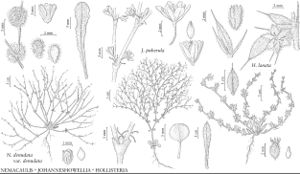Hollisteria
Proc. Amer. Acad. Arts 14: 296. 1879.
| Taxon | Illustrator ⠉ | |
|---|---|---|
 | Nemacaulis denudata var. denudata Johanneshowellia puberula Hollisteria lanata |
Herbs, annual; taproots slender. Stems arising directly from the root, spreading to decumbent or prostrate, solid, not fistulose or disarticulating into ringlike segments, tomentose. Leaves deciduous (basal) or persistent (cauline), basal and cauline, alternate; petiole indistinct at proximal node, absent at distal nodes; blade oblanceolate (proximal) or elliptic to ovate (distal), margins entire, apex mucronate. Inflorescences terminal, cymose, distally uniparous due to suppression of secondaries, each node bearing a flower; branches dichotomous, not brittle or disarticulating into segments, round, tomentose; bracts 3, typically situated at base of a cauline leaf and hidden by it, connate basally, linear to linear-lanceolate, somewhat foliaceous or scalelike, awned, thinly pubescent to densely tomentose. Peduncles absent. Involucral-bracts obvious, in whorl of 3 (–4), linear to lanceolate, awned. Flowers 1 per involucral cluster, sessile or pedicellate; perianth yellowish, broadly campanulate when open, tubular when closed, densely tomentose abaxially; tepals 6, connate proximally, monomorphic, mucronate apically; stamens 6 or 9; filaments basally adnate, glabrous; anthers yellow, oval to oblong. Achenes included, brown to black, not winged, 3-gonous, glabrous. Seeds: embryo curved. x = 21.
Discussion
Species 1.
Hollisteria is the only member of subtribe Hollisteriineae H. Gross. This view differs from that presented by J. L. Reveal and C. B. Hardham (1989), who included Chorizanthe and its relatives also in Hollisteriineae. In an unpublished thesis, Adrienne Russell (pers. comm.) has suggested that Hollisteria is more closely related to Eriogonum than to Chorizanthe. Reveal and Hardham noted that the transfer of Hollisteria from a place near Eriogonum to a position with Chorizanthe was done with “some trepidation.” There is no obvious place within Eriogonum subg. Ganysma to suggest as a point of origin for Hollisteria. Then, too, there is no place within Chorizanthe that one can comfortably suggest as such a point. By referring Hollisteria to its own subtribe, one acknowledges a relationship to Eriogonum, and recognizes that the single flower and base chromosome number of x = 21 are conditions unknown in the whole of Eriogonineae, although both features are common in Chorizanthineae.
Selected References
None.
Lower Taxa
"/2" is not declared as a valid unit of measurement for this property.